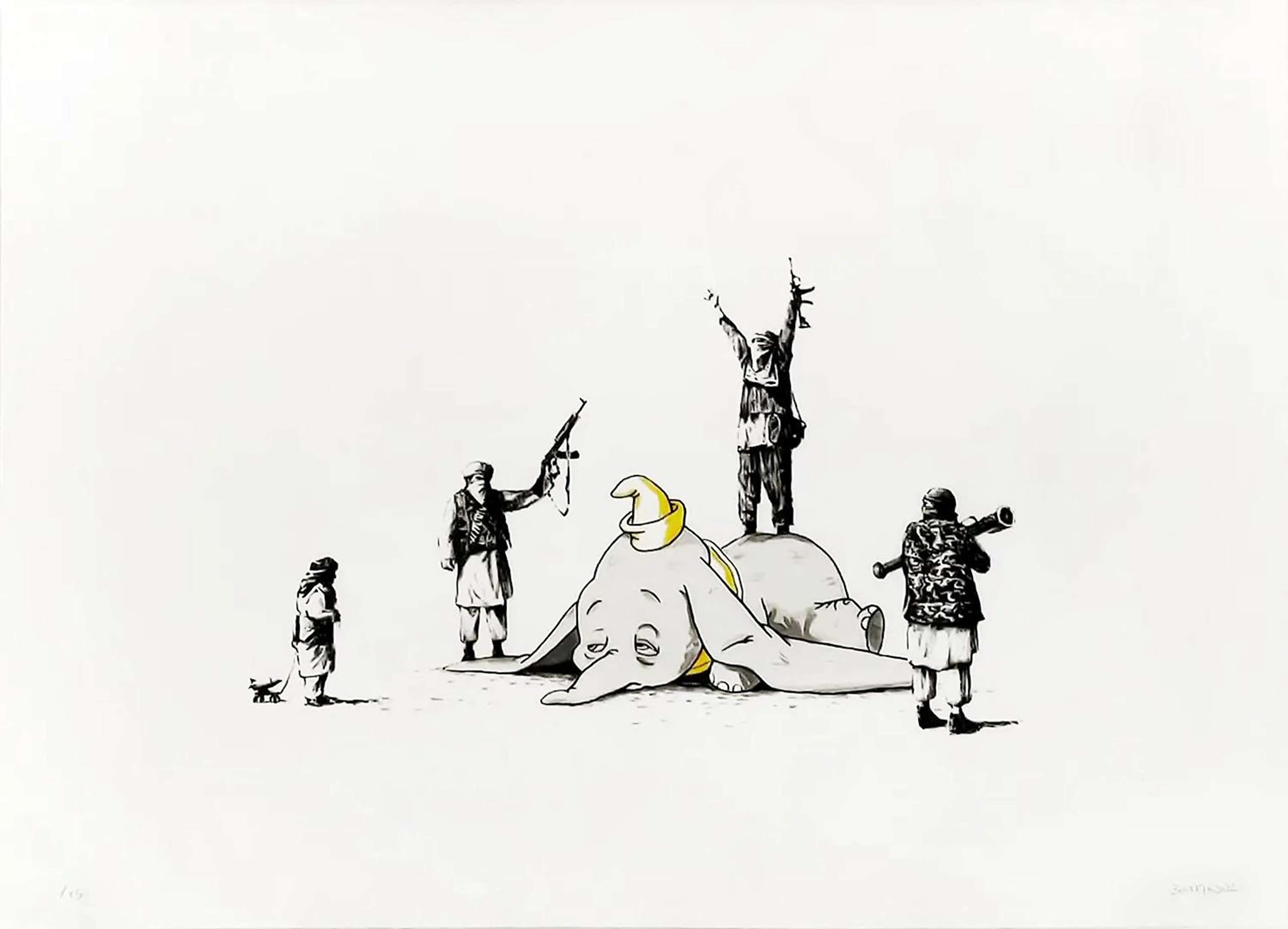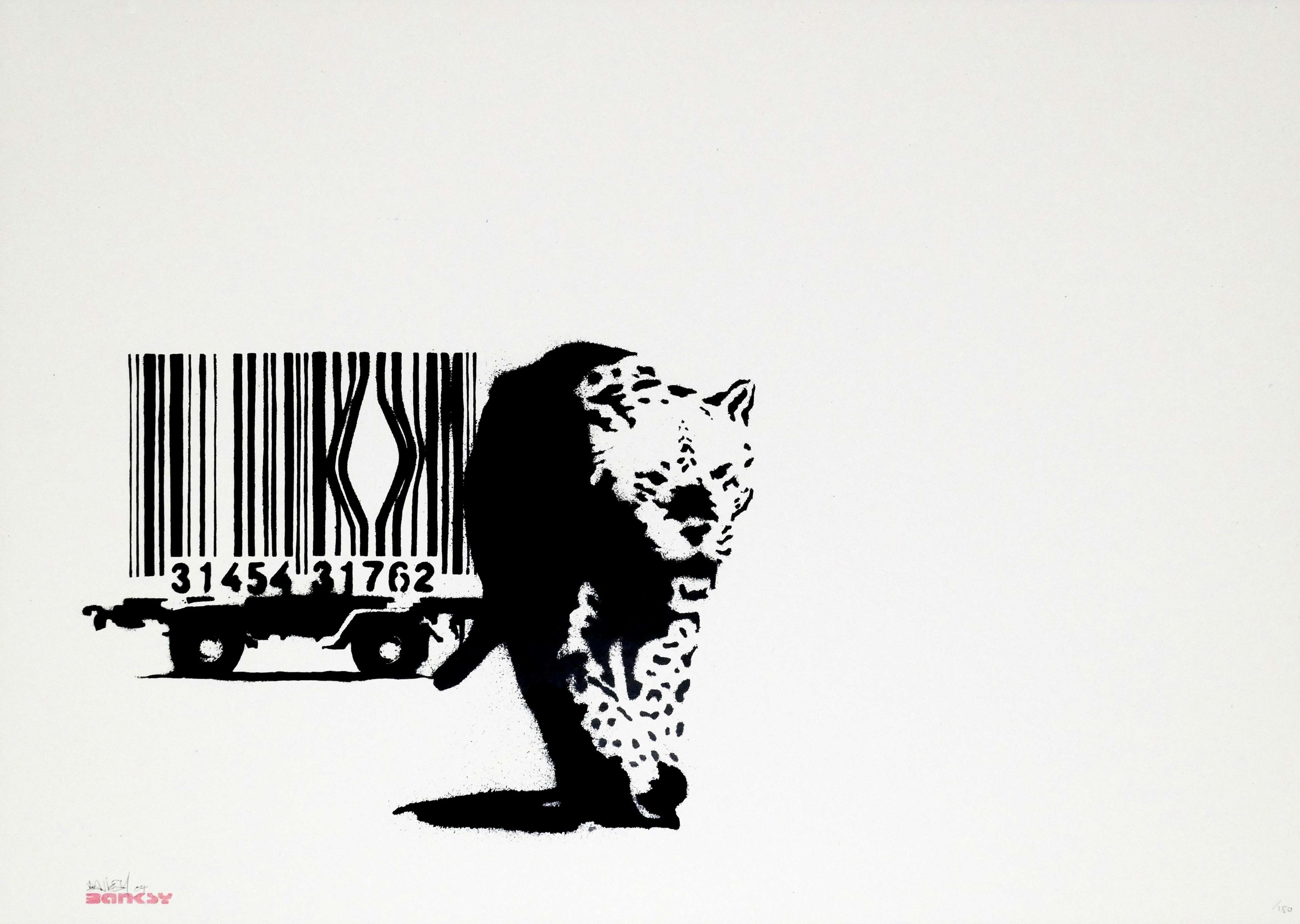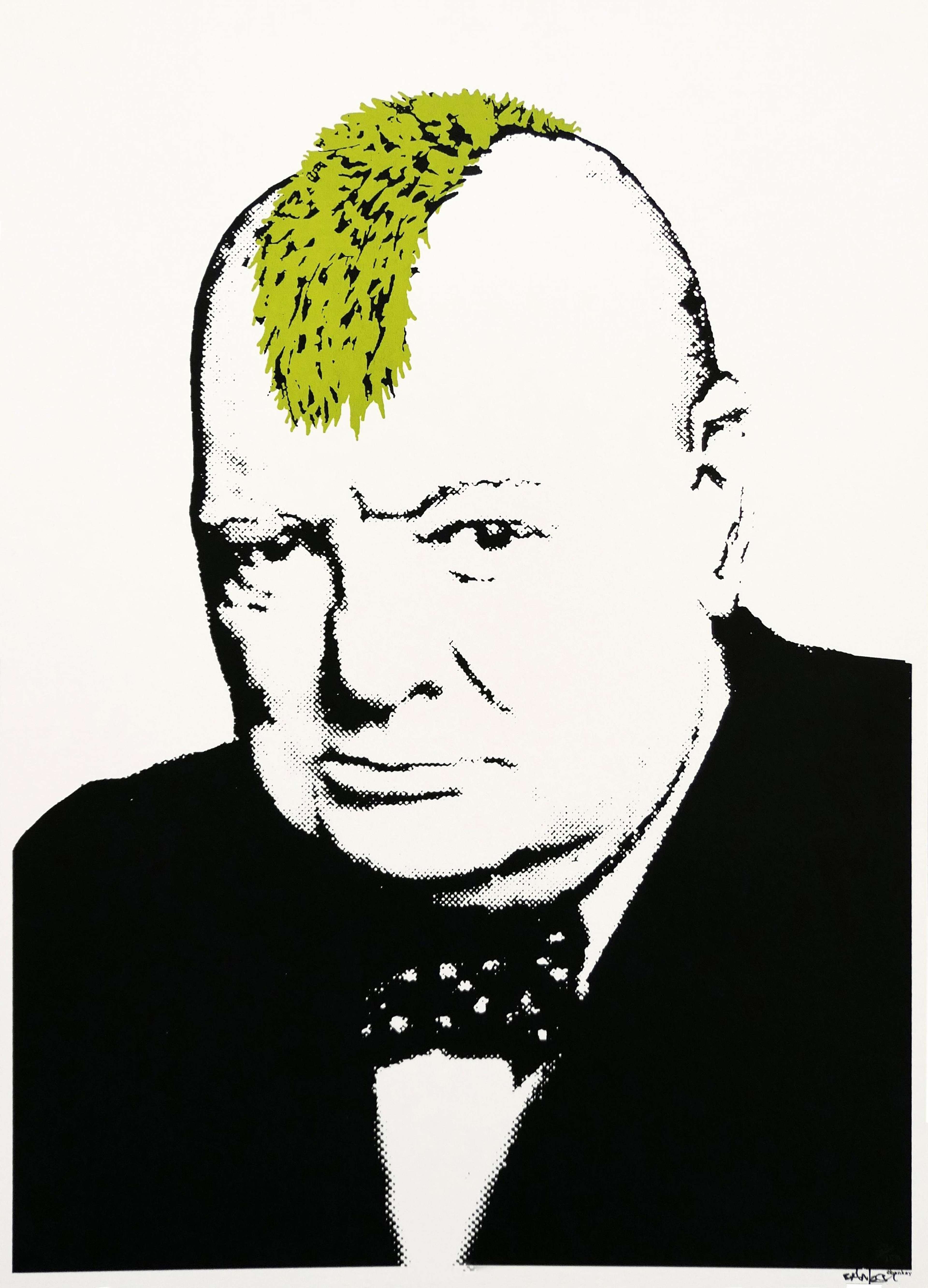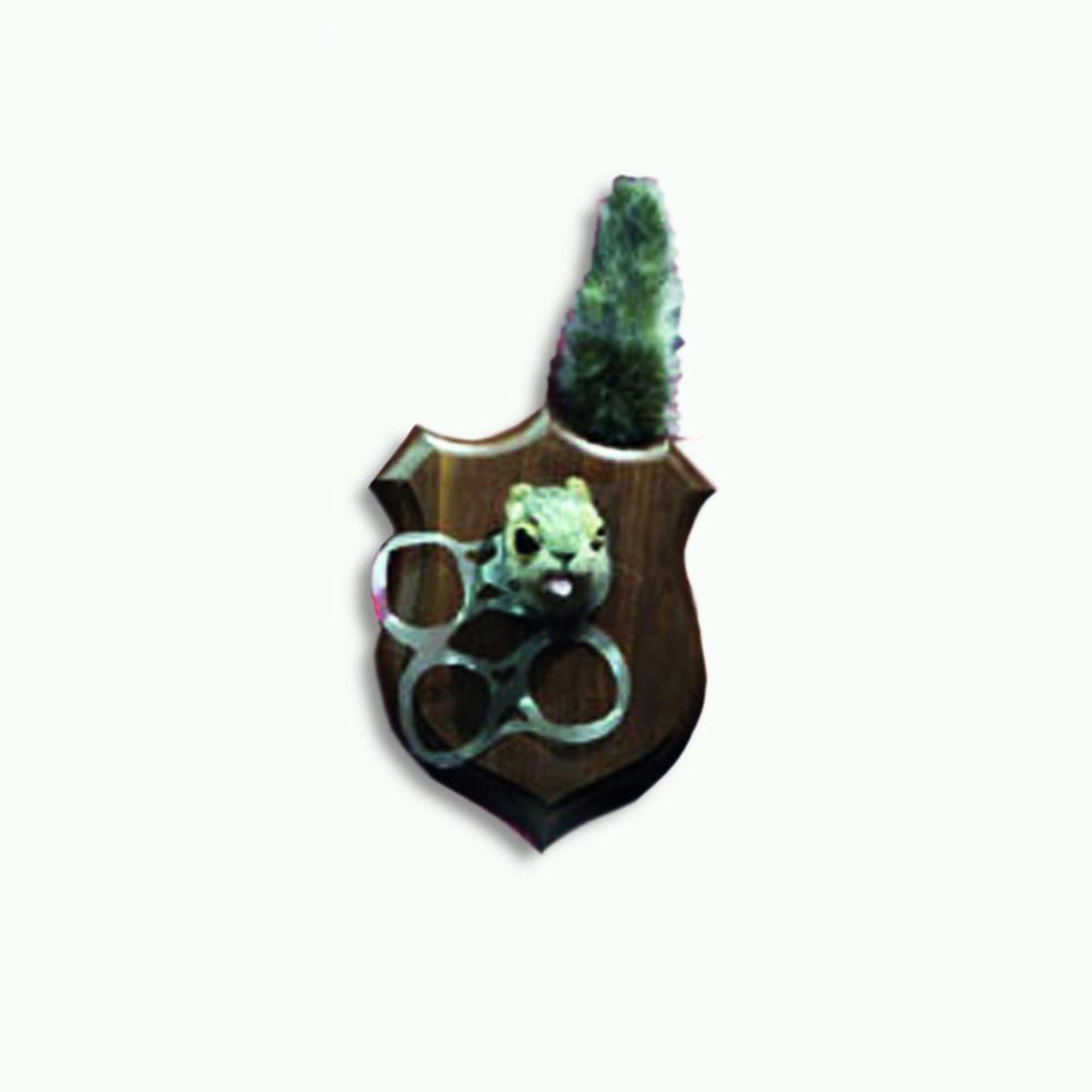 Dumbo © Banksy 2014
Dumbo © Banksy 2014
Banksy
269 works
Banksy’s engagement with animal rights activism has figured in his prints oeuvre, whilst also manifesting itself in the form of stuffed animals on a truck and the use of live animals.
Ever the master of an ironic public skit, Banksy has made a mockery of everything in popular and political culture from Mickey Mouse to Guantanamo Bay. Usually, it is quite clear to see what side of the fence Banksy sides with. When it comes to animal rights however, the line has been constantly blurred. Despite using the innocent mascot of the animal to expose the cruelty of consumerism and big corporations, Banksy himself has capitalised on the use of live, spray-painted animals in his shows. Always protected by his anonymity, the guerrilla graffitist has been able to cash in on the media frenzy when it comes to animal rights, regardless of whether he is the subject of good or bad press.
Read on to find out about times when Banksy has advocated for and exploited animal rights, as we question the role animals play in his art.
Barcode, 2004
In his 2004 print Barcode, Banksy pictures an imposing leopard slinking towards the viewer and away from its broken barcode cage. Like a lot of Banksy’s tongue-in-cheek works, Barcode can be interpreted to reveal a myriad of meanings. Perhaps Banksy is critiquing tourist-attraction zoos, which profit from the captivity of exotic animals. Given that the leopard has bent the bars of the barcode out of shape, it would seem this wild animal has broken free from the confines of consumerism. While the fabric of consumerism is fragile and breakable, the majestic leopard prevails: nature triumphs over materialism.
Turf War, 2003
In his first major official show Turf War (2003), Banksy brought together an exhibition of ‘graffiti, stencils, slogans and live animals’ in an East London warehouse. Underneath the great slogan ‘BRANDALISM’, he installed a petting zoo installation of live cows: one painted with an assortment of arrows, one with a repeated portrait of Andy Warhol, and another with a red target that read ‘Banksy’ at its centre. Clearly an attempt to poke fun at the brainwashing nature of the brand, Banksy literally branded the cow with his ‘logo’. Even though the RSPCA approved of the show, there was understandable backlash from animal rights activists. Perhaps this was always Banksy’s intention. Like so many of his public assaults on the city, his use (or misuse) of live animals was likely a premeditated choice to stir the media as much as possible.
Barely Legal, 2006
Once again in 2006, Banksy’s LA show Barely Legal confronted viewers with a real-life elephant in the room. Surrounded by satirical reworkings of old paintings in gilt-gold frames, like those we are used to seeing in big art institutions, the elephant was painted in the same pattern as the wallpaper in a feeble attempt to blend in. The visual pun is obvious, but the question still remains why did Banksy paint the elephant?
Possibly, the elephant is symbolic of the core political message of his work, often ignored by those distracted by Banksy’s commercial success. If this is the case, then the elephant’s exploitation stands-in for that of the many exploited people who form the subject of his political commentary. Rather than simply being a sensational media draw, the exploitation of the elephant is key— by leaving attendees uncomfortable with the elephant’s treatment, Banksy found effectively draws attention to the apparent lack of discomfort felt when the subject of exploitation is human.
Banksy often pokes fun at the bourgeois art collectors who pay millions for his own work. What this painted elephant proves, however, is that the art enthusiast and collector alike are willing to treat even live-animals as commodities if we label them ‘art’ – a fact best proven by Damien Hirst.
 Image © boogah (CC)BY-NC-SA 2.0 / Elephant at Banksy's Barely Legal Show © Banksy 2006
Image © boogah (CC)BY-NC-SA 2.0 / Elephant at Banksy's Barely Legal Show © Banksy 2006Heavy Weaponry, 2003
Heavy Weaponry is a simple but scathing critique of war and its enduring tie to capitalism. Set before a barcode (a favourite motif of Banksy’s), an elephant strapped with a missile takes centre position. Through his witty use of the ‘heavy’ elephant, Banksy perhaps berates the fact that we only care about matters of war when we see animals as its victims, rather than humans.
Sirens of the Lambs, 2013
Nowhere is Banksy’s love of a pun put to better use than in Sirens of the Lambs. A ‘moving sculpture’ of stuffed animal toys screeching in a van destined for the slaughterhouse, the work was driven around New York and later during Glastonbury festival in the UK. The disheveled van door was inscribed with the slogan ‘Farm Fresh Meats’, and the children’s toys were controlled like puppets from the inside of the vehicle to highlight the inhumane nature of meat farming. It is a work quite unlike the rest of Banksy’s oeuvre, but one that was neverthless effective in exciting the hot ethical debate around consuming meat. However, when it comes from an artist who is clearly not against unnaturally painting animals to attract viewers to his shows, we must question whether Banksy himself really does align with this animal-rights sentiment.
 Image © artfridge (CC)BY-NC-ND 2.0 / Sirens of the Lambs © Banksy 2013
Image © artfridge (CC)BY-NC-ND 2.0 / Sirens of the Lambs © Banksy 2013Gross Domestic Product, 2013
From his online ‘shop’ Gross Domestic Product, this series of Soft Toys were installed on his shop wall like hunting conquests. Unlike grand stag heads that we might see in a stately home however, Banksy’s stuffed animals make clear their cause of death: the thoughtless pollution of the environment by us ignorant humans. A turtle toy, wrapped with plastic bags, netting and parts of a bear can, is a macabre reminder of the consequences of polluting our oceans. Likewise, the hedgehog toy, its eye horrifically pierced with a syringe, shows the suffering of the animal in an urban landscape littered with dangerous trash. By satirising the bourgeois glorification of hunting, Banksy’s fixing of these gruesome toys to trophy plaques shows that littering is never something to be proud of.
Anti-BP Ride at Brighton Pier, 2013
Installed on Brighton beach in 2013, Banksy’s dolphin amusement ride temporarily became part of the furniture of tourist attractions lining the coast. Once again, a children’s toy is subverted and made political as the dolphin was affixed to a ‘BP’ oil canister leaking black sludge, dragging a fishing net from its tail. As the ride was constantly moving, it quickly attracted children to hop aboard, making the hard-hitting critique of the oil industry all the more disturbing.
 Anti BP Ride © Banksy 2013
Anti BP Ride © Banksy 2013London Zoo
Banksy’s latest London Zoo series has captivated the public with its blend of social commentary and mystery. In August 2024, Banksy unveiled a new animal-themed mural each day for nine days, with each piece cryptically announced at 1:00 PM on his Instagram without explanation. The series began in West London with a lone mountain goat perched precariously on Kew Bridge, sparking speculation that it represented society on the edge of collapse. Over the following days, Banksy expanded the series with a growing array of animal stencils, including elephants, monkeys, a lone wolf, and even a rhinoceros on a car, spanning across notable London locations from Chelsea to Peckham.
One of the most talked-about pieces in the series, a spray-painted gorilla at the London Zoo, depicts the primate freeing other animals from beneath a tarp, adding a twist of humor to the series while also serving as a symbolic call for liberation. With no captions to provide direct meaning, fans and critics alike have been left to interpret these images. Some speculate they allude to environmental or political issues, while others see them as a broader critique of modern captivity, both literal and figurative. True to form, Banksy has used animals to target established symbols and question their deeper meanings, reinforcing his role as both artist and social provocateur.
 Image © flickr / Banksy's Gorilla © Banksy 2024
Image © flickr / Banksy's Gorilla © Banksy 2024










